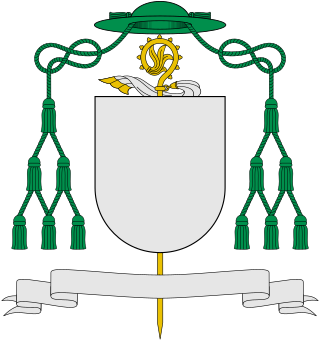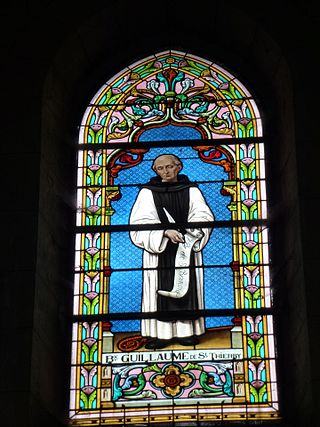Related Research Articles

Year 1089 (MLXXXIX) was a common year starting on Monday of the Julian calendar.
Pope Dionysius was the bishop of Rome from 22 July 259 to his death on 26 December 268. His task was to reorganize the Roman church, after the persecutions of Emperor Valerian I and the edict of toleration by his successor Gallienus. He also helped rebuild the churches of Cappadocia, devastated by the marauding Goths.

Ulrich of Augsburg, sometimes spelled Uodalric or Odalrici, was Prince-Bishopric of Augsburg in Germany. He was the first saint to be canonized not by a local authority but by the Pope.
Ratramnus a Frankish monk of the monastery of Corbie, near Amiens in northern France, was a Carolingian theologian known best for his writings on the Eucharist and predestination. His Eucharistic treatise, De corpore et sanguine Domini, was a counterpoint to his abbot Paschasius Radbertus’s realist Eucharistic theology. Ratramnus was also known for his defense of the monk Gottschalk, whose theology of double predestination was the center of much controversy in 9th-century France and Germany. In his own time, Ratramnus was perhaps best known for his Against the Objections of the Greeks who Slandered the Roman Church, a response to the Photian schism and defense of the filioque addition to the Niceno-Constantinopolitan Creed.

Abbo or Abbon of Fleury, also known as Saint Abbo or Abbon, was a monk and abbot of Fleury Abbey in present-day Saint-Benoît-sur-Loire near Orléans, France.

Benedict of Aniane, born Witiza and called the Second Benedict, was a Benedictine monk and monastic reformer, who left a large imprint on the religious practice of the Carolingian Empire. His feast day is either February 11 or 12, depending on liturgical calendar.

Ernulf was a French Benedictine monk who became prior of Christ Church in Canterbury, abbot of Peterborough, and bishop of Rochester in England. A jurist and an architect as well, he was responsible for greatly expanding Canterbury Cathedral during his time there.

Malachy is an Irish saint who was Archbishop of Armagh, to whom were attributed several miracles and an alleged vision of 112 popes later attributed to the apocryphal Prophecy of the Popes.

Paschasius Radbertus (785–865) was a Carolingian theologian and the abbot of Corbie, a monastery in Picardy founded in 657 or 660 by the queen regent Bathilde with a founding community of monks from Luxeuil Abbey. His most well-known and influential work is an exposition on the nature of the Eucharist written around 831, entitled De Corpore et Sanguine Domini. He was canonized in 1073 by Pope Gregory VII. His feast day is April 26. His works are edited in Patrologia Latina vol. 120 (1852) and his important tract on the Eucharist and transubstantiation, De Corpore et Sanguine Domini, in a 1969 edition by B. Paulus, published by Brepols.

The mozzetta is a short elbow-length sartorial vestment, a cape that covers the shoulders and is buttoned over the frontal breast area. It is worn over the rochet or cotta as part of choir dress by some of the clergy of the Catholic Church, among them the pope, cardinals, bishops, abbots, canons and religious superiors. There used to be a small hood on the back of the mozzetta of bishops and cardinals, but this was discontinued by Pope Paul VI. The hood, however, was retained in the mozzette of certain canons and abbots, and in that of the popes, often trimmed in satin, silk or ermine material.
Adelmann was the bishop of Brescia, in Northern Italy, during the eleventh century. Adelmann seems to have become bishop there in 1050, and to have taken an active share in the church-reform movement of the period, especially against the clerical abuses of simony and concubinage.

The Martyrology of Usuard is a work by Usuard, a monk of the Benedictine Abbey of Saint-Germain-des-Prés. The prologue is dedicated to Charles the Bald indicating that it was undertaken at that monarch's instigation. It was apparently written shortly before the author's death in 875.

A territorial abbey is a particular church of the Catholic Church comprising defined territory which is not part of a diocese but surrounds an abbey or monastery whose abbot or superior functions as ordinary for all Catholics and parishes in the territory. Such an abbot is called a territorial abbot or abbot nullius diœceseos. A territorial abbot thus differs from an ordinary abbot, who exercises authority only within the monastery's walls or to monks or canons who have taken their vows there. A territorial abbot is equivalent to a diocesan bishop in Catholic canon law.
Alberic of Monte Cassino was a Cardinal in the Roman Catholic Church, who died in 1088. He was a cardinal from 1057.
Herigerus was a Benedictine monk, often known as Heriger of Lobbes for serving as abbot of the abbey of Lobbes between 990 and 1007. Remembered for his writings as theologian and historian, Herigerus was a teacher to numerous scholars. His biography describes him as "skilled in the art of music", though no music theory treatise survives and neither do the two antiphons and one hymn attributed to him.
Osbern was a Benedictine monk, hagiographer and musician, precentor of Christ Church, Canterbury. He is sometimes confused with Osbert de Clare, alias Osbern de Westminster. He is known as "the monk Osbern" or just "Monk Osbern".

William of Saint-Thierry, O. Cist was a twelfth-century Benedictine, theologian and mystic from Liège who became abbot of Saint-Thierry in France, and later joined the Cistercian Order.
Peter Cellensis, also known as Peter of Celle, Peter of Celles, Pierre de Celle and Peter de la Celle, was a French Benedictine and bishop.
Eckbert was a Benedictine abbot of Schönau, a writer, and brother of the mystic Elisabeth of Schönau, whose life he recorded.

Saint Peter the Wonderworker or the Thaumaturge, also known as Saint Peter of Argos is a Christian saint, regarded as the patron saint of Argos.
References
This article reproduces the article in the public domain by Joseph Sollier, "Durandus of Troarn" in The Catholic Encyclopedia, Vol. 5, New York: Robert Appleton Company, 1909. available online at <http://www.newadvent.org/cathen/05208b.htm